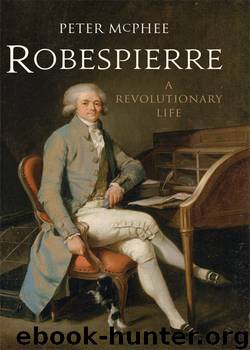Robespierre: A Revolutionary Life by Peter McPhee

Author:Peter McPhee [McPhee, Peter]
Language: eng
Format: epub
ISBN: 9780300118117
Publisher: Yale University Press
Published: 2012-03-12T22:00:00+00:00
It must be republican or royalist.
To defeat the provincial bourgeois whom he blamed for the Federalist revolts, ‘it is essential that the People allies itself with the Convention, and that the Convention makes use [se serve] of the people’. In fulfilling the Revolution's aim—‘the use of the constitution for the benefit of the people’—there were three great obstacles to overcome: the people's ignorance, their poverty and ‘the war at home and abroad’. The ‘rich and corrupt’, ‘treacherous pens and tongues’, ‘traitors and conspirators’ had to be punished ‘by making a terrible example of all the criminals who have outraged liberty, and spilt the blood of patriots’.
This was a blunt statement of Robespierre's judgement that victory in the crisis of the summer of 1793 would mean censorship, arrests and punishment of opponents as much as full-scale organization for war. He had come to the conclusion that only unrelenting commitment to creating unity of purpose, ‘a single will’, could save all that had been won since 1789 and all that remained to win. His world was now polarized into traitors and patriots. The approach of the like-minded, in government and across the Republic, would be a mobilization of all resources—military, economic, emotional—and an unremitting pursuit of internal and external enemies: the Republic would be ‘one and indivisible’. This was now a war to the death.
On 27 July ill-health obliged a member to resign from the Committee of Public Safety. The Convention accepted Robespierre as the Committee's preferred replacement.2 For the first time, he entered a government, but he entered it at the most dangerous moment. He had just turned thirty-five. Whereas other members of the Committee were usually chosen because of particular expertise, Robespierre was effectively a member without portfolio, chosen by the Convention because of his experience, standing and popularity. His reputation was at its height, but the challenges faced by him and his peers seemed overwhelming.3
Expectations of the Committee of Public Safety were formidable. Members usually gathered in the Pavillon de l'Égalité (the former Pavillon de Flore of the Tuileries Palace) at 7 a.m. to read and respond to dispatches; after attending the Convention between 1 p.m. and its closure at 4 or 5 p.m., some would attend the Jacobin Club before reconvening at the Committee at 7 or 8 p.m. Its nine members were finally increased to twelve with replacements and the appointment of other Jacobins—Carnot, Prieur de la Côte-d'Or, and the more militant Billaud-Varenne and Collot d'Herbois—in August and September. It was subject to re-election each month, but had extraordinary powers: it could issue arrest warrants (28 July), had control of secret-service expenditure (2 August), nominated the members of special committees (13 September), supervised generals and public servants (10 October) and conducted foreign policy (4 December). Finally, on 17 April 1794, the council of ministers was replaced by executive commissioners responsible to the Committee. Only the police was not under its control, but it met with the relevant Committee of General Security on twenty occasions.4
The Duplay home continued
Download
This site does not store any files on its server. We only index and link to content provided by other sites. Please contact the content providers to delete copyright contents if any and email us, we'll remove relevant links or contents immediately.
Melania and Me by Stephanie Winston Wolkoff(1041)
The Class of 83 by Hussain Zaidi(982)
Live in Love by Lauren Akins & Mark Dagostino(963)
Dancing in the Mosque by Homeira Qaderi(931)
Orlando by Virginia Woolf; Mark Hussey(924)
A History of My Brief Body by Billy-Ray Belcourt(893)
Just as I Am by Cicely Tyson(734)
The Schoolgirl Strangler by Katherine Kovacic(733)
Virginia Woolf by Between The Acts(733)
Stranger Care by Sarah Sentilles(732)
Robespierre: A Revolutionary Life by Peter McPhee(723)
Unforgetting by Roberto Lovato(714)
1914 by Luciano Canfora(709)
Ariel (english and spanish Text) by Sylvia Plath(707)
Broken Horses by Brandi Carlile(700)
Paris Without Her: A Memoir by Gregory Curtis(698)
The Common Reader, Book 1 by Virginia Woolf(697)
Harriet Tubman: The Biography by University Press(694)
Berlin Diary: The Journal of a Foreign Correspondent 1934-41 by William L. Shirer & Gordon A. Craig(694)
